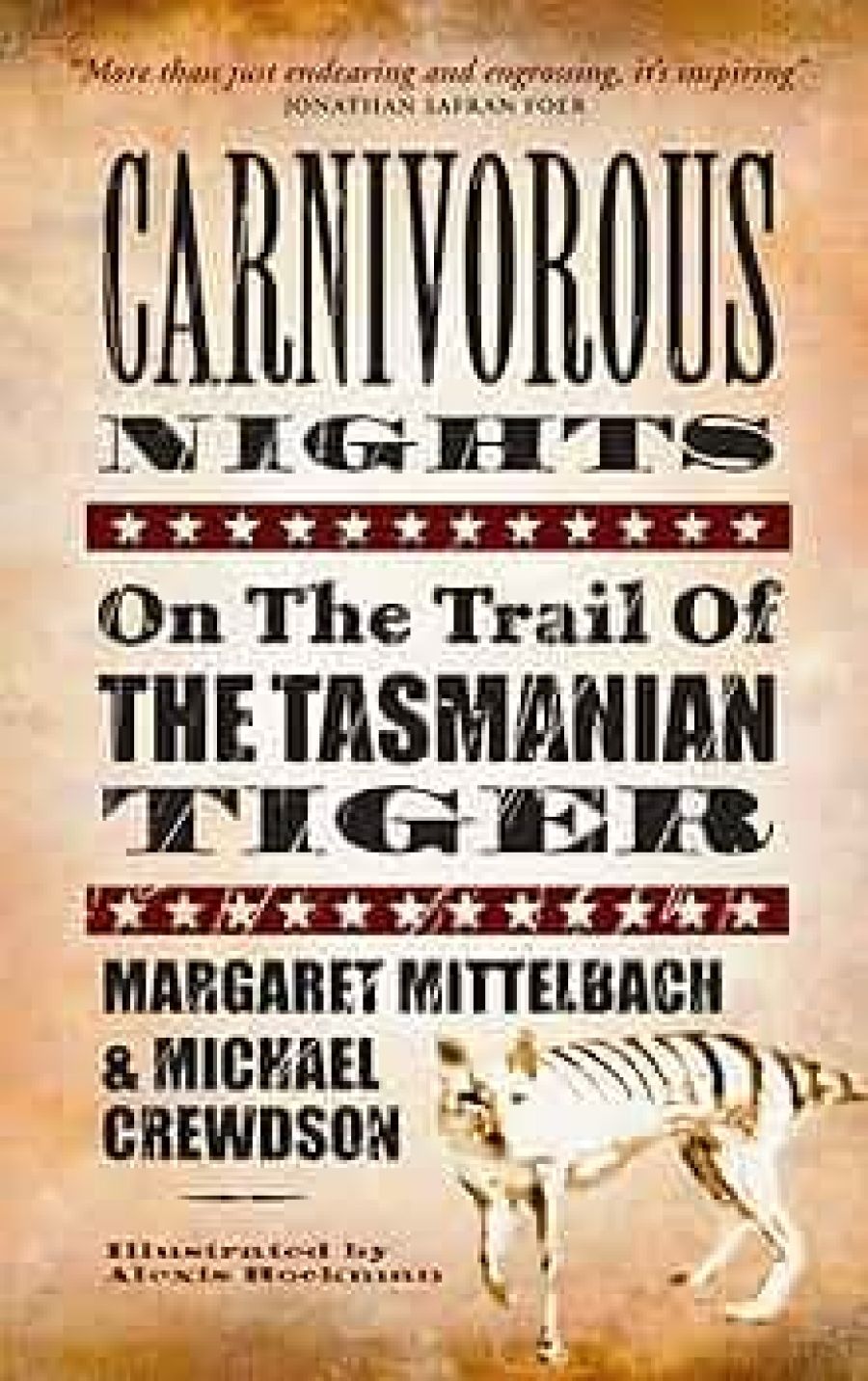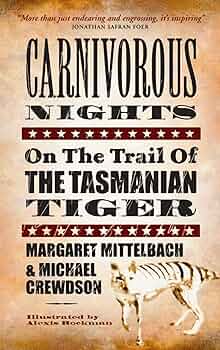
- Free Article: No
- Contents Category: Environment
- Review Article: Yes
- Article Title: Glorious Seussian stripes
- Online Only: No
- Custom Highlight Text:
It is easy to understand two New York naturalists becoming fascinated with a thylacine. Margaret Mittelbach and Michael Crewdson discovered one, stuffed and mounted, in Manhattan’s American Museum of Natural History, and began to visit it with ‘something akin to amorous fervour’. It’s equally easy to understand how this rare specimen, with its ‘glorious Seussian stripes’ and tragically fascinating mythology, inspired the pair to travel to Tasmania to learn more about its origins. What is more difficult to understand is why, once Mittelbach and Crewdson had surveyed the existing literature on the thylacine, they pressed on to write and publish Carnivorous Nights: On the Trail of the Tasmanian Tiger instead of deciding that the story had been well and truly told. On my bookshelves are Tasmanian Tiger: A Lesson to Be Learnt by Eric Guiler and Philippe Godard (1998), and David Owen’s Thylacine (2003). Close by are two novels, Heather Rose’s White Heart (1999) and Julia Leigh’s The Hunter (1999), that pursue the tiger into fictional territory. Since these are just a fraction of the books already written on the subject, I would have thought that any new tiger book would have something significant to add to the story. Carnivorous Nights, unfortunately, does not.
- Book 1 Title: Carnivorous Nights
- Book 1 Subtitle: On the trail of the Tasmanian tiger
- Book 1 Biblio: Text, $32.95 pb, 322 pp
- Book 1 Cover Small (400 x 600):

- Book 1 Cover (800 x 1200):

It tells us what we already know: that from 1830 onwards, thylacine populations were plundered by bounty hunters; that the last captive thylacine died at a Hobart Zoo on 7 September 1936; that the species is presumed extinct, but that the prospect of a few surviving individuals is the subject of sometimes intense speculation; and, finally, that there are a handful of people who would rather talk up the prospect of cloning a thylacine from remnant DNA than put much-needed effort into the immediate problem of conserving Australia’s extant native fauna.
In the closing pages of Carnivorous Nights, Mittelbach and Crewdson are sitting beneath a Cascade Brewery umbrella adorned with images of the thylacine. They observe an ironic truth, that ‘[t]hylacines [are] everywhere in Tasmania – and nowhere’. Here in Tasmania, we have a habit of fetishising the tiger, marvelling at its lost uniqueness, even while its closest cousins are being pushed to the brink. But by confining itself to the well-trodden turf, Carnivorous Nights does much the same thing. In the end, it isn’t much more than a retelling of a failed cautionary tale.
Perhaps the idea behind the book was simply to take the story of the tiger to a new, international market. Even measured against such a truncated yardstick, it is disappointing because it misses the opportunity to advance the narrative by reporting in depth on the real news in the Tasmanian bush: the current disease threat to the Tasmanian devil. Researched at a time when the threat was already apparent, the book makes only brief mention of the Devil Facial Tumour Disease that has now killed more than half the devils in the state. This epidemic, combined with the usual human pressures and habitat degradation, could cause the second species to hold the title of largest of the marsupial carnivores to follow the example of the first.
It seems that we can afford to be fascinated by the thylacine, and by human carelessness towards it, precisely because it is too late to do anything about it. Contemporary carelessness towards threatened species interests us far less because it might require us to act. But although the devil issue slips under the radar, the authors of Carnivorous Nights do infuse their story with a good measure of environmental good sense. They pay attention to the other current major threat to the survival of Tasmanian native animals: the introduction to the state of the fox. And they draw attention to the similarities between the persecution of the thylacine and current old-growth logging practices in the state.
Mittelbach and Crewdson are at their best as magpies, collecting the brightest and shiniest snippets of information about Tasmania’s flora and fauna. They dilute this strength by mixing their natural history with travelogue, describing how they and artist Alexis Rockman make their way around Tasmania in a ‘madcap adventure’ (the back of the book blurb) or, worse, ‘a postmodern safari’ (the accompanying publicity material).
The chief representative of this madcapery is Rockman, who agrees to join the authors on their trip only if he ‘can paint some fucked-up critters’ and ‘get some pot’. Including details of his pursuit of some elusive cannabis might be part of the attempt by the authors to attract a new audience to the tiger’s tale, or it might represent some kind of lame homage to Hunter S. Thompson. Sadly, it just makes the book less, rather than more, interesting.


Comments powered by CComment